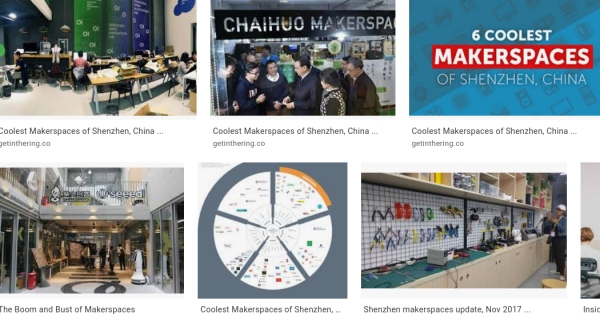Manipulated fablabs in China
More on fablabs pushed by much more than a bunch of hackers.

This is the second part (the first is here) of my summary of a paper about the institutional shaping of Fab Labs in China and Northern Ireland. Here, I synthesize the Chinese part of the paper, which is about Fab Labs in Shenzhen (China) that “have been manipulated for a specific post-industrial agenda”.
According to the study, Fab labs in Shenzhen are used as marketing tools to conceal the new wave of urban gentrification in many post-industrial cities.
Shenzhen, for example, is seeking to transform its urban image from a “dirty” mass manufacturing city to a “clean and fun” city.
The early 2000s saw many large Shenzhen factories relocate or morph into smaller, more specialised operations to align with investment in the “Shanzhai” mobile phone market. Among other things, [this] earned Shenzhen a reputation as a “cityof fakes”.
After the 2008 meltdown, efforts were made to reinvent Shenzhen’s image and, following the 2015 release of “Made in China 2025” by the State Council, hundreds of makerspaces were established in the area.
[Today] the successful transformation of Shenzhen cannot be separated from this manufacturing legacy; however, maker culture has proved an effective counter to negative perceptions of the practice.
Maker culture has been effective for three reasons: first, it legitimises Shanzhai industries by emphasising their disruptive power in relation to established global mobile phone markets; second, maker culture accentuates the grassroots DIY entrepreneurialism of Shanzhai; and third, maker culture evokes a unique form of “ingenious Chineseness, marginality and independence, and playfulness and critique” creating a new foundation for the emergent “Created in China' paradigm.
The study situates intermediary commercial corporations as secondary influencers of Shenzhen Open Innovation Lab (SZOIL). These organisations link makers to venture capitalists, global Internet of Things (IoT) platforms such as Amazon, and agile manufacturing plants located in China.
Commercial corporations occupy an important position in SZOIL’s organisation through their control of upstream and downstream services that are essential for makers.
In this context, processes of “making” are an enabler of the potentialities of associated products and business opportunities.
While many maker projects develop in the context of loose organisational control, entrepreneurial development processes at SZOIL are highly coordinated to maximise economic outcomes for makers.
At the secondary level, various local and international institutions offer the promise of streamlining services.
In practice, “despite aggressive promotion of grassroots entrepreneurialism, Shenzhen maker industries have emerged from a top-down campaign to attract external investment”. As such, makerspaces are an overt part of government-led urban regeneration strategies that aim to dramatically change the image of Shenzhen.
Leveraging the cultural capital of maker culture in the development of new urban imaginaries has successfully masked Shenzhen’s socio-economic problems with the rhetoric of progress and solutionism.
“Maker” as a term has become a powerful motif in the branding of inner city properties, and makerspaces are situated as amenity infrastructure.
Our investigation has also revealed that media conglomerates Tencent and Baidu have opened makerspaces in order to be part of an elite policy making network.
Conclusion of the study
This study has shown how the established urban ideologies that drive unique institutional practices can significantly shape makerspaces… identity politics in China and Northern Ireland - underpinned by shifting socio-economic status - has provided much of the policy momentum for makerspaces.
In China, we see the performance of a new design-led and high-tech identity to accompany its increasing global soft power;
and in Northern Ireland, a fledgling identity is emerging that emphasises skills in the development of innovative social technology.
[In both cases] Individuals involved in the makerspaces are organised under shared visions of new urban imaginaries, prescribed through policy: in China, makerspaces and maker culture [must] transform Shenzhen into a futuristic city. In Northern Ireland, ongoing social cohesion efforts were rebranded as opportunities for digital social innovation.
[However…] the current momentum could very easily stall due to shifting political sands.
(This post was drafted in May 2020, but only put online in August, because… my coronavirus reports, of course)
Who writes this, why, and how to help
I am Marco Fioretti, tech writer and aspiring polymath doing human-digital research and popularization.
I do it because YOUR civil rights and the quality of YOUR life depend every year more on how software is used AROUND you.
To this end, I have already shared more than a million words on this blog, without any paywall or user tracking, and am sharing the next million through a newsletter, also without any paywall.
The more direct support I get, the more I can continue to inform for free parents, teachers, decision makers, and everybody else who should know more stuff like this. You can support me with paid subscriptions to my newsletter, donations via PayPal (mfioretti@nexaima.net) or LiberaPay, or in any of the other ways listed here.THANKS for your support!